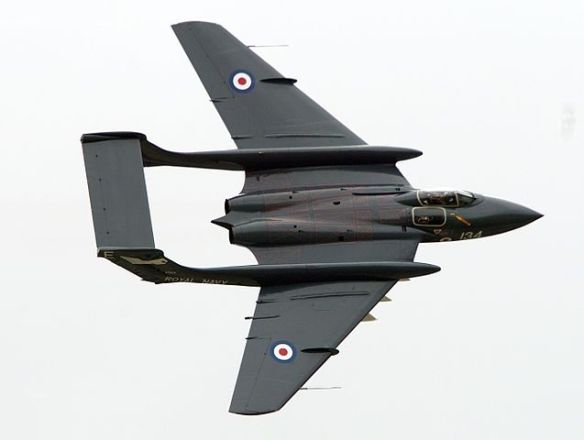A De Havilland Sea Vixen D.3 (s/n XP924, G-CVIX) at the 2009 Yeovilton Air Show. The aircraft is painted as a Sea Vixen FAW.2 of 899 Naval Air Squadron which was assigned to the aircraft carrier HMS Eagle (R05) from 1964 to 1972.
Detail from ‘Moment of Truth’ by Robert Tomlin.
The Royal Navy initially deployed improved versions of its wartime Seafire fighters before replacing them with its final piston-engined day fighter, the Hawker Sea Fury, beginning in 1947. The Sea Fury was powered by a 2,480 horsepower Bristol Centaurus radial engine that gave it a maximum speed of 460 miles per hour and a range of 680 miles. It was armed with four wing-mounted 20mm cannon and could carry up to 2,000 pounds of bombs or rockets for ground attack missions. The navy’s first jet day fighter, the Supermarine Attacker, saw relatively limited frontline service between 1951 and 1954 only. It used a single 5,100 pounds static thrust Rolls- Royce Nene turbojet to reach 590 miles per hour and had a range of 590 miles. The Attacker was armed with four 20mm cannon and most could also carry rockets or bombs. Its replacement, the Hawker Sea Hawk, offered an almost identical performance from the same power plant but possessed far superior handling both in the air and onto the flight deck. Later models were configured primarily as fighter-bombers, carrying up to 2,000 pounds of ordnance under the wings.
The Sea Hawk was the Royal Navy’s last day fighter. Its first postwar all-weather fighter was the de Havilland Sea Hornet, which entered service in 1951. This two-seater was powered by two 2,030 horsepower Rolls-Royce Merlin liquid-cooled engines that gave it a top speed of 430 miles per hour and a range of 1,500 miles. Its replacement, the de Havilland Sea Venom, went to sea in 1954 and was a two-seater powered by a single 5,300 pounds static thrust de Havilland Ghost turbojet that endowed it with a maximum speed of 575 miles per hour and a range of 950 miles. Both the Sea Hornet and the Sea Venom had the standard British armament of four 20mm cannon and could carry bombs or rockets for ground attack missions. The final British-designed all-weather fighter for the Royal Navy was the de Havilland Sea Vixen, which replaced the Sea Venom. It was a two-seater powered by two 11,230 pounds static thrust Rolls-Royce Avon turbojets, allowing it to reach Mach 0.95 at 40,000 feet and giving it a range of 1,950 miles. The Sea Vixen was exclusively missile armed, carrying four Firestreak or Red Top air-to-air missiles plus two retractable packs for unguided rockets. It entered frontline service in 1959 and was replaced, beginning in 1970, by the Royal Navy’s final fighter, a modified version of the McDonnell Phantom II using two 12,250 pounds static thrust (20,515 pounds static thrust with afterburner) Rolls-Royce Spey turbofans in place of the original American engines.
#
The formidable Sea Vixen compiled a litany of firsts for the Fleet Air Arm. It was the Royal Navy’s first all-weather interceptor, the first designed as an integrated weapons system, and the first armed solely with missiles.
In 1946 the British Admiralty issued Specification N. 40/46, later upgraded to N. 14/49, which instigated development of a twin-engine radar-equipped jet fighter. De Havilland, which had pioneered twin-boomed jet fighters, advanced the DH 110 design, but initially the navy rejected it in favor of the lower-powered Sea Venom. When the Royal Air Force also passed on it for what ultimately become the Gloster Javelin, the Fleet Air Arm took a second look and decided the craft was worth pursuing after all. The prototype debuted in 1951 as a most impressive warplane. The DH 110 was a large machine with the crew compartment and twin engines mounted within a central, streamlined pod. The twin booms streamed back from the highly swept wing and were joined farther aft by a single control surface. The pilot and radar operator sat side by side, but only the pilot was provided with a canopy, offset to the left. The DH 110 was a powerful flier, and during early testing it became the first British aircraft to break the sound barrier in a dive. When the prototype subsequently broke up in flight, development halted and several years of bureaucratic indecision ensued. Consequently, the first FAW. 1 Sea Vixens did not reach the fleet until 1959.
In service the Sea Vixen proved itself a powerful addition to the fleet, both as an interceptor and a ground-attack plane (mounting U. S.-made Bullpup guided missiles). By 1961 a new version, the FAW. 2, appeared, featuring revised booms extending over the front wing to carry additional fuel. This model also was the first navy fighter to dispense with cannons entirely in favor of four Firestreak or Red Top missiles. A total of 148 Sea Vixens were built, with the last retiring in 1972.
Dimensions: wingspan, 50 feet; length, 55 feet, 7 inches; height, 10 feet, 9 inches
Weights: empty, 22,000; gross, 36,000 pounds
Power plant: 2 x 11,250-pound thrust Rolls-Royce Avon turbojet engines
Performance: maximum speed, 650 miles per hour; ceiling, 48,000 feet; range, 600 miles
Armament: 4 x Firestreak, Red Top, or Bullpup missiles
Service dates: 1959-1972
